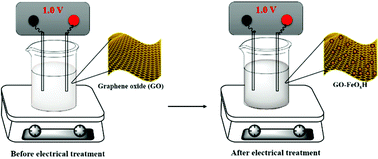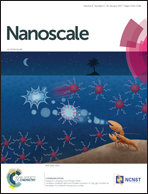Near infrared light-mediated enhancement of reactive oxygen species generation through electron transfer from graphene oxide to iron hydroxide/oxide†
Abstract
Clinical applications of current photodynamic therapy (PDT) agents are often restricted to be activated only by UV and visible light, which have very poor tissue penetration depths. In this study, a new near infrared (NIR)-absorbing nanoagent based on graphene oxide decorated with iron hydroxide/oxide (GO–FeOxH) was developed for light-activated nanomaterial-mediated PDT. This nanocomposite, GO–FeOxH was prepared via the one-step electrooxidation of iron nails in an aqueous GO solution. The as-prepared GO–FeOxH showed a much higher reactive oxygen species (ROS) activity under NIR light irradiation than GO. Through a variety of spectroscopic analyses, the mechanism involved in the enhancement of ROS activity of GO by FeOxH was systematically investigated. We observed that NIR light irradiation promotes electron transfer from GO to the Fe(III) of FeOxH and accelerates their reaction with O2, forming superoxide anion radicals, which then undergo a disproportionation reaction to produce H2O2. H2O2 then reacts with Fe(II) in FeOxH to mediate Fenton reactions, producing amplified hydroxyl radicals. Using in vitro studies, we demonstrated that GO–FeOxH can be used as a NIR activatable PDT nanoagent, providing efficient cancer therapy.



 Please wait while we load your content...
Please wait while we load your content...